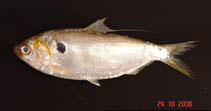Beobachtung melden im Fish Watcher
| Native range | All suitable habitat | Point map | Year 2050 |

|
| This map was computer-generated and has not yet been reviewed. |
| Konosirus punctatus AquaMaps Data sources: GBIF OBIS |
Hochladen Photos und videos
Pictures | Google BildKonosirus punctatus
Picture by Liu, J.
Pictures | Google BildKonosirus punctatus
Picture by Liu, J.
Japan country information
Common names:
Konoshiro, コノシロ
Occurrence: native
Salinity: brackish
Abundance: common (usually seen) | Ref: Sokolovskaya, T.G., A.S. Sokolovskii and E.I. Sobolevskii, 1998
Importance: | Ref:
Aquaculture: | Ref:
Regulations: | Ref:
Uses: no uses
Comments: Occurs in southern Japan, south of Matsushima Bay and Fukui Prefecture (Ref. 11230). Also Ref. 188, 637, 57032.
National Checklist:
Country Information: https://www.cia.gov/library/publications/resources/the-world-factbook/geos/ja.html
National Fisheries Authority: http://www.maff.go.jp/eindex.html
Occurrences: Occurrences Point map
Main Ref: Masuda, H., K. Amaoka, C. Araga, T. Uyeno and T. Yoshino, 1984
National Database:
Occurrence: native
Salinity: brackish
Abundance: common (usually seen) | Ref: Sokolovskaya, T.G., A.S. Sokolovskii and E.I. Sobolevskii, 1998
Importance: | Ref:
Aquaculture: | Ref:
Regulations: | Ref:
Uses: no uses
Comments: Occurs in southern Japan, south of Matsushima Bay and Fukui Prefecture (Ref. 11230). Also Ref. 188, 637, 57032.
National Checklist:
Country Information: https://www.cia.gov/library/publications/resources/the-world-factbook/geos/ja.html
National Fisheries Authority: http://www.maff.go.jp/eindex.html
Occurrences: Occurrences Point map
Main Ref: Masuda, H., K. Amaoka, C. Araga, T. Uyeno and T. Yoshino, 1984
National Database:
Common names from other countries
Klassifizierung / Names Namen | Synonyme | Catalog of Fishes(Gattung, Arten) | ITIS | CoL | WoRMS | Cloffa
> Clupeiformes (Herrings) > Dorosomatidae (Gizzard shads and sardinellas)
Etymology: Konosirus: Japanese, konoshiro, a fish eaten in Kumihama City, in the Sea of Japan.
More on authors: Temminck & Schlegel.
Etymology: Konosirus: Japanese, konoshiro, a fish eaten in Kumihama City, in the Sea of Japan.
More on authors: Temminck & Schlegel.
Environment: milieu / climate zone / depth range / distribution range Ökologie
seewasser; brackwasser; ozeanodrom (Ref. 51243). Subtropical; 42°N - 23°N, 117°E - 138°E (Ref. 54453)
Verbreitung Länder | FAO Gebiete | Ecosystems | Vorkommen | Point map | Einführungen | Faunafri
Indo-West Pacific: coasts of Japan from about 38°N southward; Sea of Japan north to Vladivostok on mainland; also Yellow Sea, including Gulf of Pohai and East China Sea south to Taiwan Island and Hong Kong).
Length at first maturity / Size / Gewicht / Alter
Kurzbeschreibung Bestimmungsschlüssel | Morphologie | Morphometrie
Rückenflossenstacheln (insgesamt) : 0; Afterflossenstacheln: 0; Afterflossenweichstrahlen: 192 - 27. Body moderately slender, moderately compressed, belly with 17 to 21 (usually 19 or 20) + 12 to 16 (usually 14 or 15), total 32 to 37 (usually 34 or 35) scutes; no pre-dorsal scutes. Snout projecting slightly; gill rakers of first arch at least 3/4 length of gill filaments. Vertebrae 46 to 51 (usually 49, also 48 or 51). A dark spot behind gill opening, followed by several lines of dark dots.
Found off coasts and in bays, but migrating into shallower brackish water for breeding, at least in Ariake Sound (south Kyushu), where spawning takes place far up the Sound in April and May. Individuals apparently spawn twice or more during the season.
Life cycle and mating behavior Geschlechtsreife | Fortpflanzung | Ablaichen | Eier | Fecundity | Larven
Hauptreferenz
Upload your references | Referenzen | Koordinator | Partner
Whitehead, P.J.P., 1985. FAO Species Catalogue. Vol. 7. Clupeoid fishes of the world (suborder Clupeoidei). An annotated and illustrated catalogue of the herrings, sardines, pilchards, sprats, shads, anchovies and wolf-herrings. FAO Fish. Synop. 125(7/1):1-303. Rome: FAO. (Ref. 188)
IUCN Rote Liste Status (Ref. 130435: Version 2024-2)
nicht bedroht (LC) ; Date assessed: 28 February 2017
Bedrohung für Menschen
Harmless
Nutzung durch Menschen
Fischereien: weniger kommerziell
FAO(Aquaculture systems: production; Fischereien: production, Artbeschreibung; publication : search) | FishSource | Sea Around Us
Mehr Information
Population dynamics
Growth parameters
Max. ages / sizes
Length-weight rel.
Length-length rel.
Längenhäufigkeiten
Mass conversion
Rekrutierung
Dichte
Growth parameters
Max. ages / sizes
Length-weight rel.
Length-length rel.
Längenhäufigkeiten
Mass conversion
Rekrutierung
Dichte
Life cycle
Fortpflanzung
Geschlechtsreife
Fecundity
Ablaichen
Spawning aggregations
Eier
Eientwicklung
Larven
Larven Pop.Dyn.
Fortpflanzung
Geschlechtsreife
Fecundity
Ablaichen
Spawning aggregations
Eier
Eientwicklung
Larven
Larven Pop.Dyn.
Anatomy
Kiemenoberfläche
Brain
Otolith
Kiemenoberfläche
Brain
Otolith
Physiology
Body composition
Nutrients
Oxygen consumption
Swimming type
Swimming speed
Visual pigments
Fish sound
Diseases & Parasites
Toxicity (LC50s)
Body composition
Nutrients
Oxygen consumption
Swimming type
Swimming speed
Visual pigments
Fish sound
Diseases & Parasites
Toxicity (LC50s)
Genetics
Genetik
Heterozygosity
Vererbbarkeit
Genetik
Heterozygosity
Vererbbarkeit
Human related
Aquaculture systems
Aquakultur Profile
Zuchtlinien
Ciguatera cases
Stamps, coins, misc.
Aquaculture systems
Aquakultur Profile
Zuchtlinien
Ciguatera cases
Stamps, coins, misc.
Tools
E-book | Feldführer | Bestimmungsschlüssel | Längenhäufigkeits Tool | Lebensdaten Tool | Punkt Karte | Classification Tree
| Catch-MSY |
Zusatzinformationen
Download XML
Zusammenfassung | Point data | Namen | Photos
Internet Quellen
Aquatic Commons | BHL | Cloffa | Websites from users | FishWatcher Einträge suchen | CISTI | Catalog of Fishes(Gattung, Arten) | DiscoverLife | ECOTOX | Faunafri | Fishtrace | GenBank(Genom, nucleotide) | GloBI | GOBASE | | Google Books | Google Scholar | Google | IGFA World Record | MitoFish | Nationale Datenbanken | Otolith Atlas of Taiwan Fishes | PubMed | Reef Life Survey | Scirus | SeaLifeBase | Tree of Life | Wikipedia(Gehe zu, Suchen) | World Records Freshwater Fishing | Zoological Record
Estimates based on models
Preferred temperature (Ref. 115969): 16.1 - 23.8, mean 20.3 (based on 86 cells).
Phylogenetic diversity index (Ref. 82804): PD50 = 1.0000 [Uniqueness, from 0.5 = low to 2.0 = high].
Bayesian length-weight: a=0.00851 (0.00748 - 0.00969), b=3.05 (3.02 - 3.08), in cm Total Length, based on LWR estimates for this species (Ref. 93245).
Trophic level (Ref. 69278): 2.9 ±0.24 se; based on food items.
Widerstandsfähigkeit (Ref. 120179): hoch, Verdopplung der Population dauert weniger als 15 Monate. (Assuming tm=1).
Fishing Vulnerability (Ref. 59153): Moderate vulnerability (36 of 100).
Climate Vulnerability (Ref. 125649): High to very high vulnerability (65 of 100).




